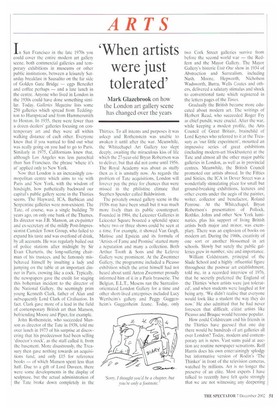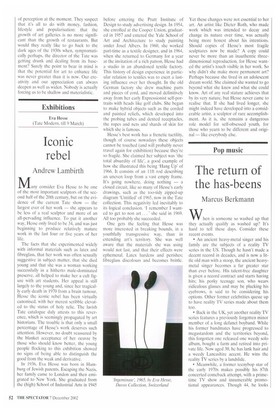'When artists were just tolerated'
Mark Glazebrook on how the London art gallery scene has changed over the years
In San Francisco in the late 1970s you could cover the entire modern art gallery scene, both commercial galleries and temporary exhibitions in museums or other public institutions, between a leisurely Saturday breakfast in Sausalito on the far side
of Golden Gate Bridge eggs Benedict and coffee perhaps — and a late lunch in the centre. Anyone who lived in London in the 1930s could have done something similar. Today, Galleries Magazine lists some 250 galleries which spread from Teddington to Hampstead and from Hammersmith to Hoxton, In 1935, there were fewer than a dozen dealers' galleries focusing on contemporary art and they were all within walking distance of each other. Everyone knew that if you wanted to find out what was really going on you had to go to Paris. Similarly in 1975, Californians knew that, although Los Angeles was less parochial than San Francisco, the phrase 'where it's at' applied only to New York.
Now that London is an increasingly cosmopolitan centre which aims to vie with Paris and New York, with the wisdom of hindsight, how pathetically backward our capital's public gallery scene in the Thirties seems. The Hayward, ICA, Barbican and Serpentine galleries were non-existent. The Tate, of course, was a single building 70 years ago, on only one bank of the Thames. Its director was J.B. Manson, an ex-painter and ex-secretary of the mildly Post-Impressionist Camden Town Group, who failed to expand his taste and was overfond of drink, by all accounts. He was regularly bailed out of police stations after midnight by Sir Evan Charteris, the long-suffering chairman of his trustees, and he famously misbehaved himself by insulting a lady and jumping on the table at an important dinner in Paris, crowing like a cock. Typically, the newspapers gave the credit for staging this bohemian incident to the director of the National Gallery, the seemingly prim young Kenneth Clark, father of Alan and subsequently Lord Clark of Civilisation. In fact. Clark gave more of a lead in the field of contemporary British art than Manson, befriending Moore and Piper, for example.
John Rothenstein, who succeeded Manson as director of the Tate in 1938, told me over lunch in 1973 of his surprise at discovering that his predecessor had been selling 'director's stock', as the staff called it, from the basement. More disastrously, the Treasury then gave nothing towards an acquisitions fund, and only .E15 for reference books — of which Manson spent less than half. Due to a gift of Lord Duveen, there were some developments in the display of sculpture, but the actual administration of the Tate broke down completely in the Thirties. To all intents and purposes it was asleep and Rothenstein was unable to awaken it until after the war. Meanwhile, the Whitechapel Art Gallery too slept deeply, awaiting the miraculous kiss of life which the 27-year-old Bryan Robertson was to deliver, but that did not come until 1956. The Royal Academy was about as stuffy then as it is unstuffy now. As regards the problem of Tate acquisitions, London will forever pay the price for chances that were missed in the philistine climate that Stephen Spender called Baldwinism.
The privately owned gallery scene in the 1930s may have been small but it was much more lively than its public counterpart. Founded in 1904, the Leicester Galleries in Leicester Square boasted a splendid space where two or three shows could be seen at a time. For example, it showed Van Gogh, Matisse and Epstein and its formula of 'Artists of Fame and Promise' started many a reputation and many a collection. Both Arthur Tooth & Sons and the Lefevre Gallery were prominent. At the Zwemmer Gallery. the programme included a Picasso exhibition which the artist himself had not heard about until Anton Zwemmer proudly informed him of it in a Paris brasserie. The Belgian, E.L,T., Mesens ran the Surrealistorientated London Gallery for a time and other short-lived enterprises included Lucy Wertheim's gallery and Peggy Guggenheim's Guggenheim Jeune. Today, only
two Cork Street galleries survive from before the second world war — the Redfern and the Mayor Gallery. The Mayor Gallery's historic Unit One show in 1934 of Abstraction and Surrealism, including Nash, Moore, Hepworth, Nicholson Wadsworth, Burra, Wells Coates and others, delivered a salutarystimulus and shock to conventional taste which registered in the letters pages of the Times.
Gradually the British became more educated about modern art. The writings of Herbert Read, who succeeded Roger Fry as chief pundit, were crucial, After the war, while keeping a modest profile, the Arts Council of Great Britain, brainchild of Lord Keynes who referred to it at the Treasury as our little experiment', mounted an impressive series of great exhibitions (including modern-art blockbusters) at the Tate and almost all the other major public galleries in London, as well as in provincial centres. Meanwhile, the British Council promoted our artists abroad. In the Fifties and Sixties, the ICA in Dover Street was a wonderfully stimulating place for small but ground-breaking exhibitions, lectures and other events under the aegis of the painter, writer, collector and benefactor, Roland Penrose. At the Whitechapel, Bryan Robertson's presentation of Pollock, Rothko. Johns and other New York luminaries, plus his support of living British artists both major and m inor, was exemplary. There was an explosion of books on modern art. During the 1960s, creativity of one sort or another blossomed in art schools. Slowly but surely the public galleries grew in number, size and importance.
William Coldstream, principal of the Slade School and a highly influential figure throughout the postwar art establishment, told me, in a recorded interview of 1976, that he secretly preferred the England of the Thirties 'when artists were just tolerated', and when students were laughed at for being arty. 'We didn't realise that everyone would look like a student the way they do now.' He also admitted that he had never foreseen that difficult, elitist artists like Picasso and Braque would become popular.
How could Coldstream and his friends in the Thirties have guessed that one day there would be hundreds of art galleries all over London? Today, modern and contemporary art is news. Vast sums paid at auction are routine newspaper sensations. Rolf Harris does his own entertainingly splodgy but informative version of Rodin's 'The Thinker' in front of the television cameras, watched by millions. Art is no longer the preserve of an elite. Most experts I have talked to recently have felt quite strongly that we are not witnessing any deepening of perception at the moment. They suspect that it's all to do with money, fashion, lifestyle and popularisation: that the growth of art galleries is no more significant than the growth of restaurants. But would they really like to go back to the dark ages of the 1930s when, symptomatically perhaps, the director of the Tate was getting drunk and dealing from its basement? Surely the point to bear in mind is that the potential for art to enhance life was never greater than it is now. Our creativity and our appreciation can always deepen as well as widen. Nobody is actually forcing us to be shallow and materialistic.











































































 Previous page
Previous page